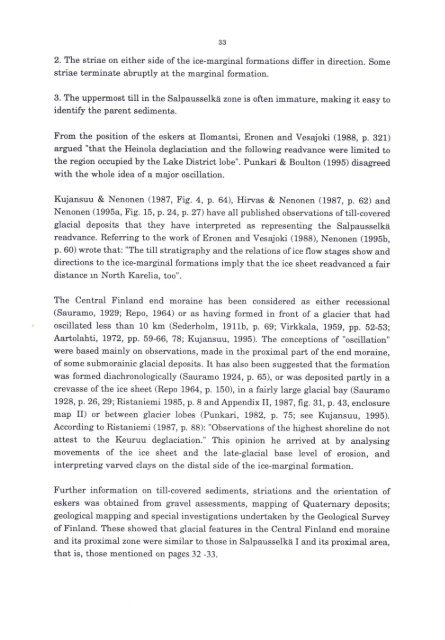DEGLACIATION IN EASTERN AND CENTRAL ... - arkisto.gsf.fi
DEGLACIATION IN EASTERN AND CENTRAL ... - arkisto.gsf.fi
DEGLACIATION IN EASTERN AND CENTRAL ... - arkisto.gsf.fi
You also want an ePaper? Increase the reach of your titles
YUMPU automatically turns print PDFs into web optimized ePapers that Google loves.
33<br />
2. The striae on either side of the ice-marginal ice-marginal formations differ in direction. Some<br />
striae terminate abruptly at the marginal marginal formation. fomation.<br />
3. The uppermost uppemost till in the Salpausselkä Salpausselkä zone is often immature, immature, making it easy to<br />
identify the parent sediments. sediments.<br />
From the position of the eskers at Ilomantsi, llomantsi, Eronen Eronen and Vesajoki Vesqjoki (1988, p. 321)<br />
argued "that the Heinola Heinola deglaciation deglaciation and the following following readvance were limited to<br />
the region region occupied occupied by the Lake Lake District District lobe". Punkari Punkari & Boulton (1995) disagreed<br />
with the whole idea of a major major oscillation. oscillation.<br />
Kujansuu & Nenonen (1987, Fig. 4, p. 64), Hirvas Hirvas & Nenonen (1987, (1982, p. 62) and<br />
Nenonen Nenonen (1995a, Fig. 15, p. p.24,p.27)have 24, p. 27) have all published published observations oftill-covered<br />
of till-covered<br />
glacial deposits that they have interpreted interpreted as representing representing the Salpausselkä<br />
readvance. Referring to the the work of ofEronen Eronen and Vesajoki vesajoki (1988), (1988), Nenonen (1995b, (lgg5b,<br />
p. 60) wrote that: "The till stratigraphy and the relations relations of o<strong>fi</strong>ce ice flow stages show and<br />
directions directions to the ice-marginal ice-margindl formations formations imply that that the ice sheet readvanced a fair<br />
distance distance m rn North Karelia, Karelia. too".<br />
The Central Finland end moraine has has been been considered as either either recessional<br />
(Sauramo, 1929; Repo, 1964) or or as having having formed formed in front of a glacier glacier that had<br />
oscillated less than 10 km (Sederholm, 1911b, p. 69; Virkkala, 1959, pp. 52-53; b2-b3;<br />
Aartolahti, 1972, pp. pp.59-66, 59-66, 78; Kujansuu, 1995). 19g5). The conceptions of "oscillation"<br />
"oscillation"<br />
were based based mainly on observations, made in in the proximal part part of the end moraine,<br />
of of some some submorainic submorainic glacial deposits. It has also been been suggested that the formation<br />
was formed diachronologically diachronologically (Saurn- (Sauramo o 1924, p. 65), or was deposited partly in a<br />
crevasse crevasse of of the ice ice sheet (Repo 1964, p. 150), in in a fairly large glacial bay (Saur"-o (Sauramo<br />
1928, p. 26,29;Ristaniemi 26, 29; Ristaniemi 1985, p.8 p. 8 andAppendixll, and Appendix H, 1982, 1987, <strong>fi</strong>g. 81, 31, p.43, p. 43, enclosure<br />
map II) or between glacier lobes (PunkaÄ, (Punkari, 1982, p. 75; 75; see Kujansuu, Kujansuu, 199b). 1995).<br />
According According to Ristaniemi Ristaniemi (1987, p. 88): "observations "Observations of the highest shoreline do not<br />
attest to the Keuruu deglaciation." This opinion he arrived at by analysing<br />
movements of the ice sheet and the late-glacial base level of erosion, and<br />
interpreting varved clays on the the distal distal side of the the ice-marginal ice-marginal formation.<br />
Further Further information information on till-covered till-covered sediments, sediments, striations and the orientation of<br />
eskers eskers was obtained from gravel assessments, mapping mapping of Quaternary Quatemary deposits;<br />
geological mapping and special investigations investigations undertaken by the Geological Sun'ey Survey<br />
of Finland. These These showed that glacial features in the Central Finland end moraine<br />
and its proximal zone were similar to those in Salpausselkä I and its proximal proximal area,<br />
that is, those mentioned on pages 32 -33.<br />
that is, those mentioned on pages 32 -33.

















